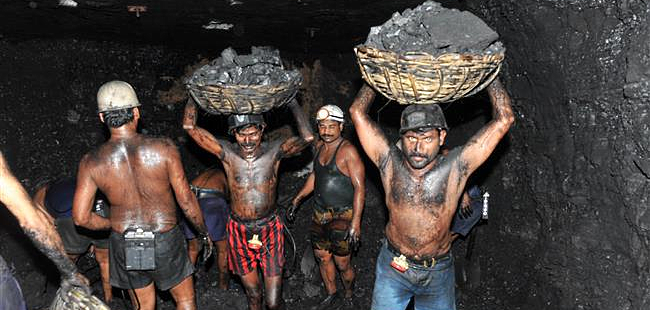
INDIA NEED URANIUM: TENFOLD

WNN - India is planning a tenfold increase in uranium production over the next 15 years, Minister of State Jitendra Singh told the country's parliament yesterday. State company Uranium Corporation of India Ltd (UCIL) has outlined expansion plans to meet the Department of Atomic Energy's (DAE) vision of achieving self-sufficiency in uranium production.
In answer to questions in the Lok Sabha, Singh said UCIL, which is a public service undertaking with the DAE, has outlined a plan for "massive expansion" leading to a tenfold rise in uranium production by 2031-2032. The plan includes maintenance of sustained supply from existing facilities, capacity expansion of some existing units and construction of new production centres (mines and plants) in different parts of the country, he said.
"Considering the resources already identified in different geological basins by Atomic Minerals Directorate for Exploration and Research (AMD), a constituent unit of DAE, UCIL's major production centres are planned in Jharkhand, Andhra Pradesh, Karnataka, Telangana, Rajasthan and Meghalaya," Singh said.
The expansion is planned in three phases, with the first expected to increase uranium production to 3.5 times existing levels by the "12th year". Completion of projects in the second phase is expected to achieve a sevenfold expansion over current production, with the third phase of projects leading to a tenfold increase over current levels by 2031-32.
According to the 2016 edition of the OECD Nuclear Energy Agency and International Atomic Energy Agency joint report on uranium resources, production and demand (the 'Red Book'), India's known conventional uranium resources - reasonably assured resources and inferred - were estimated to be 181 606 tU as of January 2015. Uranium mills currently operate at Jadugudah and Turamdih, both in Jharkand, and Tummalapalle in Andhra Pradesh. India produced 385 tU in 2015. The AMD claimed to have established domestic uranium resources of 232,315 tU as of November last year.
India operates 22 nuclear reactors, eight of which are fuelled by indigenous uranium. Fourteen reactors are under international safeguards and use imported uranium. Six units - four indigenously designed pressurised heavy water reactors, a fast breeder reactor and a Russian-designed pressurised water reactor - are currently under construction. Construction is planned to begin on 19 further units within the next few years, including ten indigenously designed PHWRs which are scheduled to start up by 2031. Agreements envisage the import of uranium up to 2020, Singh said.
-----
Earlier:

2018, March, 7, 14:30:00
ASIA'S NUCLEAR INCREASINGEIA - Nuclear electricity generation capacity in the Middle East is expected to increase from 3.6 gigawatts (GW) in 2018 to 14.1 GW by 2028 because of new construction starts and recent agreements between Middle East countries and nuclear vendors.
|

2018, March, 7, 14:10:00
INDIA - VIETNAM NUCLEARWNN - India and Vietnam have signed a memorandum of understanding (MoU) to strengthen their cooperation in nuclear energy. The agreement was one of three MoUs signed during Vietnamese President Tran Dai Quang's visit to India.
|

2018, March, 4, 11:00:00
RUSSIA - INDIA - BANGLADESH NUCLEARROSATOM, the Ministry of Science and Technology of the People's Republic of Bangladesh and the Department of Atomic Energy of the Government of the Republic of India signed a Memorandum of Understanding on cooperation in the implementation of the Rooppur NPP construction project in Bangladesh. |

2018, January, 22, 08:15:00
INDIA'S NUCLEAR POWER - 2017WNA - India has a flourishing and largely indigenous nuclear power programme and expects to have 14.6 GWe nuclear capacity on line by 2024 and 63 GWe by 2032. It aims to supply 25% of electricity from nuclear power by 2050.
|

2017, December, 15, 12:55:00
NUCLEAR - 2050: 25%WNN - According to the Foratom statement, World Nuclear Association Director General Agneta Rising said: "By 2050, nuclear energy must account for 25% of energy generation if we are to meet our climate targets. With nuclear making up 11% of generation in 2014, an extra 1000 GWe in nuclear capacity will need to be built by 2050. However, meeting this goal will not be easy."
|

2017, November, 9, 13:50:00
EIA: NUCLEAR ENERGY WILL UPEIA projects that global nuclear capacity will grow at an average annual rate of 1.6% from 2016 through 2040, led predominantly by countries outside of the Organization for Economic Cooperation and Development (OECD). EIA expects China to continue leading world nuclear growth, followed by India. This growth is expected to offset declines in nuclear capacity in the United States, Japan, and countries in Europe.
|

2017, October, 25, 21:26:00
THE BIGGEST ASIAN NUCLEARWNN - Asian countries continue to dominate the market for new nuclear build, according to a newly-released report from the World Nuclear Association. Of the 10 new nuclear power reactors that started up worldwide in 2016, eight were located in Asia. |













